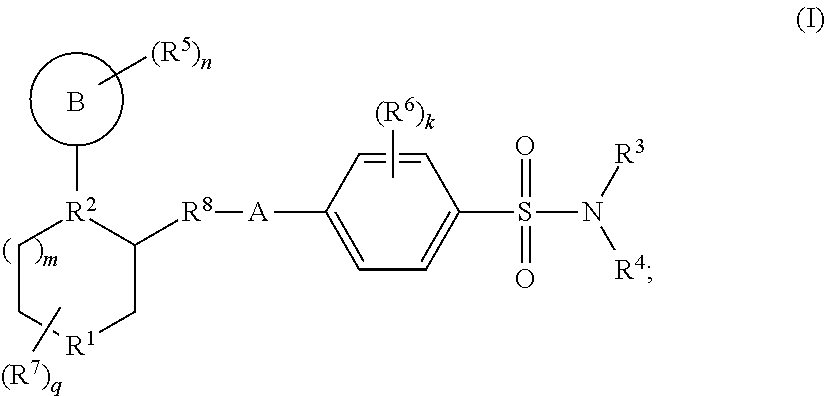Benzenesulfonamide compounds and their use as therapeutic agents
a technology of benzenesulfonamide and compound, applied in the field of benzenesulfonamide compounds, can solve the problems of major pathophysiological conditions, major changes, and the effect of reducing the adverse events associated with sub>v/sub>1.1 in the cns
- Summary
- Abstract
- Description
- Claims
- Application Information
AI Technical Summary
Benefits of technology
Problems solved by technology
Method used
Image
Examples
example 1
Synthesis of trans-tert-butyl 4-(4-chlorophenyl)-3-(hydroxymethyl)piperidine-1-carboxylate
[0442]
[0443]A. To a stirred solution of trans-methyl 4-(4-chlorophenyl)-1-methylpiperidine-3-carboxylate (2.70 g, 10.1 mmol, prepared according to Kozikowski, A. P. et. al. J. Med. Chem. 1998, 41, 1962) in 1,2-dichloroethane (50 mL) was added 1-chloroethyl chloroformate (1.4 mL, 13 mmol) at 0° C. The reaction mixture was stirred for 30 minutes at 0° C., and then heated at reflux for 4 h. The residue obtained after concentration in vacuo was dissolved in methanol (50 mL), and the resulting mixture was heated at reflux for 18 h and concentrated in vacuo. The residue was dissolved in methylene chloride (50 mL), and triethylamine (7.0 mL, 50 mmol) and di-tert-butyl dicarbonate (3.30 g, 15.1 mmol) were added. The reaction mixture was stirred at ambient temperature for 20 h and concentrated in vacuo. The residue was diluted with ethyl acetate (200 mL) and washed with saturated sodium bicarbonate solu...
example 2
Synthesis of trans-tert-butyl 4-(4-fluorophenyl)-3-(hydroxymethyl)piperidine-1-carboxylate
[0445]
[0446]A. Following the procedure as described in Step A of EXAMPLE 1 and making non-critical variations to replace trans-methyl 4-(4-chlorophenyl)-1-methylpiperidine-3-carboxylate with trans-methyl 4-(4-fluorophenyl)-1-methylpiperidine-3-carboxylate (prepared according to the methods disclosed in U.S. Pat. No. 4,007,196), trans-1-tert-butyl 3-methyl 4-(4-fluorophenyl)piperidine-1,3-dicarboxylate was obtained in 62% yield (8.40 g) as a colorless oil: 1H NMR (300 MHz, CDCl3)δ 7.16-7.07 (m, 2H), 6.99-6.91 (m, 2H), 4.45-4.12 (m, 2H), 3.42 (s, 3H), 2.95-2.55 (m, 4H), 1.84-1.52 (m, 2H), 1.46 (s, 9H).
[0447]B. Following the procedure as described in Step B of EXAMPLE 1 and making non-critical variations to replace trans-1-tert-butyl 3-methyl 4-(4-chlorophenyl)piperidine-1,3-dicarboxylate with trans-1-tert-butyl 3-methyl 4-(4-fluorophenyl)piperidine-1,3-dicarboxylate, trans-tert-butyl 4-(4-fluorop...
example 3
Synthesis of (3S,4R)-tert-butyl 4-(4-fluorophenyl)-3-(hydroxymethyl)piperidine-1-carboxylate
[0448]
[0449]To a stirred solution of ((3S,4R)-4-(4-fluorophenyl)piperidin-3-yl)methanol (1.00 g, 4.8 mmol) in methylene chloride (20 mL), was added triethylamine (1.30 mL, 9.3 mmol) and di-tert-butyl dicarbonate (1.50 g, 6.9 mmol). The resulting reaction mixture was stirred at ambient temperature for 20 h and concentrated in vacuo. The residue was dissolved in ethyl acetate (200 mL) and washed with saturated sodium bicarbonate solution (50 mL) and brine (50 mL); dried over anhydrous sodium sulfate and filtered. The filtrate was concentrated in vacuo, and the residue was purified by column chromatography (30% ethyl acetate in hexanes) to afford (3S,4R)-tert-butyl 4-(4-fluorophenyl)-3-(hydroxymethyl)piperidine-1-carboxylate in 92% yield (1.36 g) as a colorless solid: 1H NMR (300 MHz, CDCl3) δ 7.22 (d, J=8.4 Hz, 2H), 7.08 (d, J=8.4 Hz, 2H), 4.50-4.15 (m, 2H), 3.43 (s, 3H), 2.95-2.58 (m, 4H), 1.8...
PUM
| Property | Measurement | Unit |
|---|---|---|
| enantiomeric excess | aaaaa | aaaaa |
| enantiomeric excess | aaaaa | aaaaa |
| enantiomeric excess | aaaaa | aaaaa |
Abstract
Description
Claims
Application Information
 Login to View More
Login to View More - R&D
- Intellectual Property
- Life Sciences
- Materials
- Tech Scout
- Unparalleled Data Quality
- Higher Quality Content
- 60% Fewer Hallucinations
Browse by: Latest US Patents, China's latest patents, Technical Efficacy Thesaurus, Application Domain, Technology Topic, Popular Technical Reports.
© 2025 PatSnap. All rights reserved.Legal|Privacy policy|Modern Slavery Act Transparency Statement|Sitemap|About US| Contact US: help@patsnap.com



